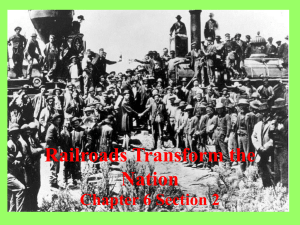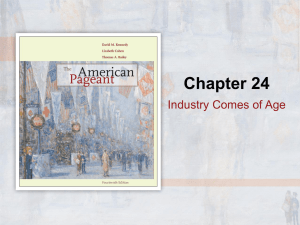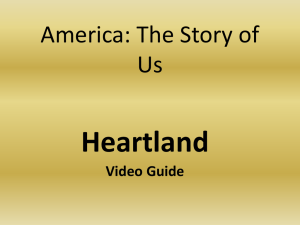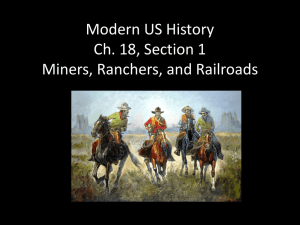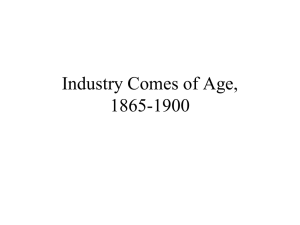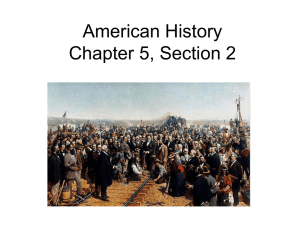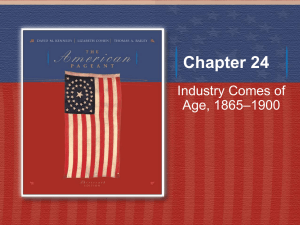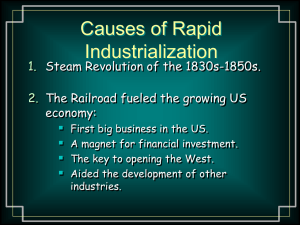The Transcontinental Railroad
advertisement
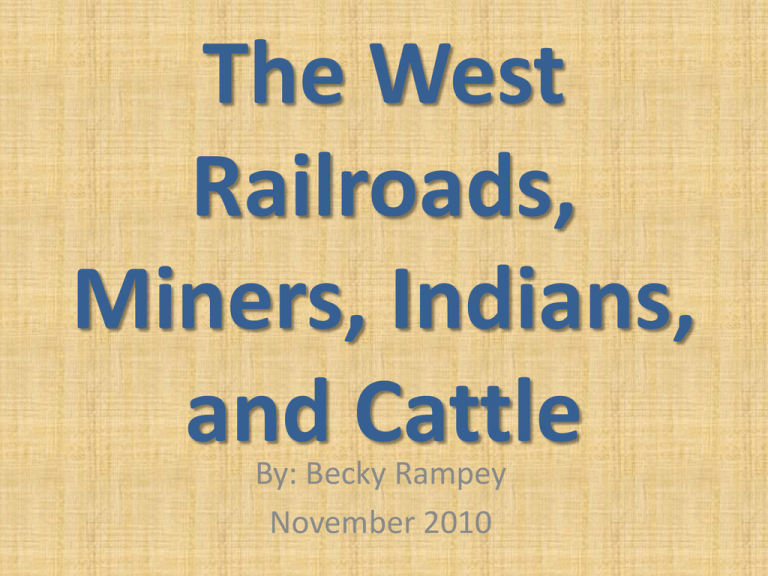
The West Railroads, Miners, Indians, and Cattle By: Becky Rampey November 2010 Prospecting Mining Centers: 1900 Anaconda Copper Mining Co. (MT) Mining (“Boom”) Towns-Now Ghost Towns Calico, CA Railroads had already transformed life in the East, but at the end of the Civil War railroad tracks still stopped at the Missouri River. For a quarter of a century, men had dreamed of building a line from coast to coast. Now they would attempt to lay 1,775 miles of track from Omaha to Sacramento. The Transcontinental Railroad The Transcontinental Railroad It was 1,775 miles from Omaha, NE to Sacramento, CA. The Transcontinent al Railroad A path would have to be cut through mountains higher than any railroadbuilder had ever faced; span deserts where there was no water anywhere; and cross treeless prairies where anxious and defiant Indians would resist their passage. The Transcontinental Railroad In 1862, Congress gave charters to two companies to build these tracks. The Central Pacific was to push eastward from Sacramento, over the Sierra Nevada mountains. The Union Pacific was to start from Omaha Nebraska, cross the great plains and cut through the Rockies. Slide #4 The Union Pacific and Central Pacific were soon locked in a race to see who could lay the most track -- and therefore get the most land and money. Somewhere in the West -- no one knew exactly where -- the two lines were supposed to meet. The Transcontinental Railroad The Transcontinental Railroad Theodore Judah discovered a route for the railroad through the Sierra mountains. He and Doc Strong formed the Central Pacific Railroad. They located four Sacramento investors who each purchased $15,000 of stock in the newly born Central Pacific Railroad. These men became known as the “Big Four.” The Transcontinental Railroad In 1862, Congress loaned the Central Pacific and Union Pacific Railroads $16,000 per mile of level track and $48,000 per mile of mountain track. Congress also promised each company 6,400 acres of federal land for every mile of track it laid. The Transcontinental Railroad In 1865, Crocker, in charge of construction, found a solution to their work force problem. Besides hiring Irish immigrants who worked for low pay, the Central pacific Railroad employed over 10,000 Chinese immigrants. The Transcontinental Railroad In 1866, the CPR had 44 blizzards while trying to tunnel through the Sierras. In 1869, the CPR laid 360 miles of track. On April 28, 1869, the CPR crew set a record of laying 10 miles in twelve hours. The Impact of the Railroads Before the railroads, each town kept its own time, based on the position of the sun. Railroad companies, however, needed more exact time tables. They devised a system with four time zones – eastern, central, mountain and pacific time. Every place within the same time zone observed the same time. The Impact of the Railroads In 1869, George Westinghouse helped make railway travel safer and faster with the invention of a new air brake. On early trains, each railroad car had its own brakes and brake operator. If different cars stopped at different times, accidents resulted. The new air brake allowed an engineer to stop all the cars at once. Promontory Point, Utah Omaha, Nebraska . Central Pacific Railroad x Union Pacific Railroad . J j Sacramento, California · In 1863, two companies, the Union Pacific and the Central Pacific, began building the first transcontinental railroad. “White manpower, the kind employers preferred, was in desperately short supply, diverted by the call to arms or the shout of “Eureka!” in the goldfields. The few white recruits who did straggle in…leaned on their picks when the boss rode away and shouldered their shovels on payday.” Central Pacific approximately 90% of their workforce were Chinese immigrants Immigrant Workers · Labor was Union Pacific - scarce due to the hired many hard, dangerous Irish work and low immigrants pay. · Therefore, immigrant labor was used. “The Central Pacific management even considered importing 5,000 Rebel prisoners (the Civil War’s end foiled the plan) and peons from Mexico (rejected as too lazy). Diligent beyond a doubt were some 40,000 Chinese already in California. But “rice eating weaklings”? "The Chinese Question" Harper’s Weekly, February 18, 1871 by, Thomas Nast “PACIFIC CHIVALRY” Harper’s Weekly, August 7, 1869, page 512 (Nast Cartoon) · The workers endured scorching deserts, blinding snowstorms, and blasted through mountains. Chinese railroad workers perform their duties in the snow. The Transcontinental Railroad Finally, on May 10, 1869, The CPR and UPR met at Promontory Summit, Utah. The presidents of both railroads, Stanford and Durant, swung at the last gold spike. On May 10, 1869, a golden spike was hammered into a track joining the two tracks in Promontory Point, UT. Gold-plated Golden Spike that was donated by the governor of Arizona Territory. Spike is now owned by the Museum of the City of New York. Photo by poster, 12/06 The Impact of the Railroads The railroads spurred economic growth. Steel-workers turned millions of tons of iron into steel for tracks and engines. Lumberjacks supplied wood for railroad ties. Miners dug coal to fuel the engines. The railroads opened every corner of the country to settlement and growth. Driving Cattle to Market · After the Civil War, growing cities in the East increased their demand for beef. · Texas ranchers began to drive herds of longhorns hundreds of miles north to the railroads, where they were shipped east. • Cowhands learned their trade from Spanish vaqueros. · Cowhands had to worry about stampedes, cattle thieves, and the dry, hot weather. · Cow towns developed near the railroads, offering cowhands hotels, saloons, and restaurants. Abilene, Kansas (late 1800’s) Caldwell, Kansas (1880’s) Wichita, Kansas (1874) Dodge City, Kansas, 1874 "Kansas has but one Dodge City, with a broad expanse of territory sufficiently vast for an empire; we have only room for one Dodge City; Dodge, a synonym for all that is wild, reckless, and violent; Hell on the Plains." -- A Kansas Newspaper in the 1870's The Open Range Cattle Boom · Cattle roamed free on the plains. Cowboys at the end of an 1897 roundup in Ward County, Texas, pose with their herd of almost 2,000 cattle. · Ranchers rounded them up twice a year and branded newborn calves. The Cattle Trails * The spread of farming, as well as harsh weather, destroyed the cattle boom by 1887. Hundreds of miles of barbed wire were strung across the state in the 1880s, forever changing the character of the frontier and bringing a measure of management to the cattle industry. Barbed Wire Joseph Glidden Regional Population Distribution by Race: 1900 Regional Population Distribution by Race: 1900 Exoduster Homesteaders The Buffalo Soldiers & the Indian Wars The Buffalo Soldiers on the Great Plains African American & Chinese Populations: 1880-1900 Frontier Settlements: 1870-1890 1887 Land Promotion Poster for the Dakota Territories A Pioneer’s Sod House, SD The Traditional View of the West A Romantic View William “Buffalo Bill” Cody’s Wild West Show “Buffalo Bill” Cody & Sitting Bull Legendary Female Western Characters Calamity Jane Annie Oakley Destruction of the Buffalo Herds The near extinction of the buffalo. Yellowstone National Park First national park established in 1872. National Parks
